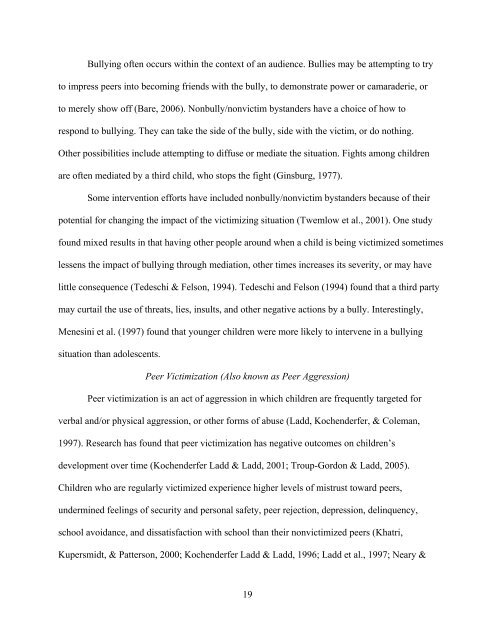Copyright Malvin Porter, Jr. 2010 - acumen - The University of ...
Copyright Malvin Porter, Jr. 2010 - acumen - The University of ...
Copyright Malvin Porter, Jr. 2010 - acumen - The University of ...
Create successful ePaper yourself
Turn your PDF publications into a flip-book with our unique Google optimized e-Paper software.
Bullying <strong>of</strong>ten occurs within the context <strong>of</strong> an audience. Bullies may be attempting to try<br />
to impress peers into becoming friends with the bully, to demonstrate power or camaraderie, or<br />
to merely show <strong>of</strong>f (Bare, 2006). Nonbully/nonvictim bystanders have a choice <strong>of</strong> how to<br />
respond to bullying. <strong>The</strong>y can take the side <strong>of</strong> the bully, side with the victim, or do nothing.<br />
Other possibilities include attempting to diffuse or mediate the situation. Fights among children<br />
are <strong>of</strong>ten mediated by a third child, who stops the fight (Ginsburg, 1977).<br />
Some intervention efforts have included nonbully/nonvictim bystanders because <strong>of</strong> their<br />
potential for changing the impact <strong>of</strong> the victimizing situation (Twemlow et al., 2001). One study<br />
found mixed results in that having other people around when a child is being victimized sometimes<br />
lessens the impact <strong>of</strong> bullying through mediation, other times increases its severity, or may have<br />
little consequence (Tedeschi & Felson, 1994). Tedeschi and Felson (1994) found that a third party<br />
may curtail the use <strong>of</strong> threats, lies, insults, and other negative actions by a bully. Interestingly,<br />
Menesini et al. (1997) found that younger children were more likely to intervene in a bullying<br />
situation than adolescents.<br />
Peer Victimization (Also known as Peer Aggression)<br />
Peer victimization is an act <strong>of</strong> aggression in which children are frequently targeted for<br />
verbal and/or physical aggression, or other forms <strong>of</strong> abuse (Ladd, Kochenderfer, & Coleman,<br />
1997). Research has found that peer victimization has negative outcomes on children’s<br />
development over time (Kochenderfer Ladd & Ladd, 2001; Troup-Gordon & Ladd, 2005).<br />
Children who are regularly victimized experience higher levels <strong>of</strong> mistrust toward peers,<br />
undermined feelings <strong>of</strong> security and personal safety, peer rejection, depression, delinquency,<br />
school avoidance, and dissatisfaction with school than their nonvictimized peers (Khatri,<br />
Kupersmidt, & Patterson, 2000; Kochenderfer Ladd & Ladd, 1996; Ladd et al., 1997; Neary &<br />
19

















